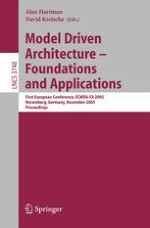2005 | Buch
Model Driven Architecture – Foundations and Applications
First European Conference, ECMDA-FA 2005, Nuremberg, Germany, November 7-10, 2005. Proceedings
herausgegeben von: Alan Hartman, David Kreische
Verlag: Springer Berlin Heidelberg
Buchreihe : Lecture Notes in Computer Science
